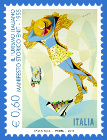The talking statues of Rome

What's a talking statue, you ask?
Rome, the capital of Italy, the Eternal City. It is a city rich of architectural and urban planning, and not only, belonging to different centuries, always lure of tourists from all over the world.
Perhaps not everyone knows that Rome is also the city of the so-called "talking statues"... Located in strategic and popular points, six of them are today particularly known: Pasquino, Marforio, Madama Lucrezia, Il Babuino , Il Facchino and Abbot Luigi . But why are they called talking statues?
When statues were found during the Renaissance and afterwards that weren't seized by noble families for their own mansions, they were placed in strategic places of Rome and started being considered as an outlet for political criticism (something Romans have always excelled in!). Consider it something between a 3D comics strip and a prototype of a bulletin board!
Since the 16th century, the Romans used to hang on the neck of the statues some satirical protests - called "pasquinate" from Pasquino, the best-known character of the group - situated behind Navona Square. They were usually written in Latin language in the form of verse or dialogue, and directed against the politicians and the Pope, that were becoming more and more despots. These irreverent satires were absolutely anonymous (among other things they were displayed in the night when no one could see), but the authority was very afraid because everyone could read them, or have them read as many people could neither read nor write, and so become the subject of mockery.
Since the pasquinate were awkward, many popes tried to get rid of the statues, but no one really succeeded.
Since it was uncertain the origin of the sculptures, they were identified with nicknames. Pasquino, for example, is meant to date to the 3rd century B.C., but we do not know if it represents a deity, a gladiator, or a king. And where was it found? A legend tells that it was owned by an innkeeper, a tailor or barber named, of course, Pasquino. Today there is only a fragment of the original statue, perhaps part of a group representing Menelaus supporting a corpse.
While Pasquino is a simple male torso, Marforio is a full figure of a man with a beard, lying on a triclivio that seems a sea god (or the river Tiber?). It is located in the courtyard of Palazzo Nuovo, a wing of the Capitoline Museums, but its original location was the Roman Forum.
Madama Lucrezia is a statue without arms and nose which represents a female figure, coming from a temple dedicated to Isis. Maybe it was a goddess, but it was so named because a noblewoman, Lucretia d'Alagna, had lived in the neighborhood of the statue after she was forced to move from Naples to Rome because he was not able to obtain from the Pope the divorce of her lover, King Alfonso of Aragon.
Il Babuino, lying on a fountain, is a grinning Silenus (minor god of the woods) and is located in Via del Babuino, once called via Paolina.
Il Facchino is a small fountain and represents a man in a typical porter suit, while pouring water from a barrel.
Abbot Luigi is located near Navona Square, and is a Roman with a toga, perhaps a senior magistrate. The name probably derives from the sacristan of the church nearby that looked like him.
Plaster casts of Pasquino and Abbot Luigi are now in the Museo of Rome in Trastevere.
What is the most surprising thing? These statues are still used to express anonymous opinions, criticisms and suggestions!
You just have to request your tour there and see yourself... to understand who is the person mocked!














